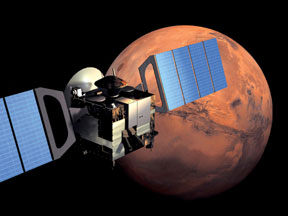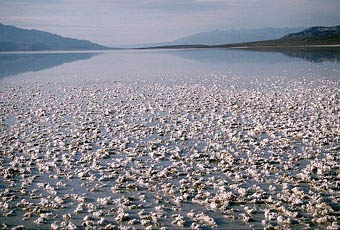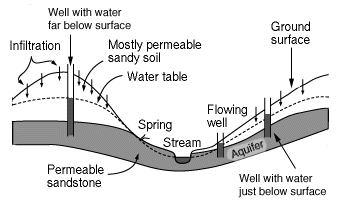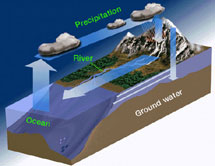This picture above how rainwater filters down to the saturated zone.
Groundwater
You have seen water in lakes, rivers, and even your bathtub. But some water hides below the ground. Itís called groundwater!
If you traveled underground deep enough, you would find that the rocks around you are full with water. Thatís deeper than the water table! The water in the rocks is called an aquifer. In dry places, the water table might be very deep, but in moist places it is very shallow. When the water table is higher than the ground, there are streams, rivers, and lakes on the land surface.
Water gets into an aquifer from the surface. Rainwater soaks into the ground and flows down to the water table.
Sometimes pollution gets into groundwater. We need to be careful to protect our water and keep it clean!
Last modified May 5, 2003 by Lisa Gardiner.
You might also be interested in:

Rivers are very important to Earth because they are major forces that shape the landscape. Also, they provide transportation and water for drinking, washing and farming. Rivers can flow on land or underground
...more
The European Space Agency (ESA) launched a mission to Mars in June of 2003. The mission is called "Mars Express". The Mars Express spacecraft has two parts. One part will orbit Mars for at least one Martian
...more
Some sedimentary rocks are made of mineral crystals that come from oceans, lakes, and groundwater. Water can have all the ingredients that are needed to make mineral crystals! How does water hold the
...more
An aquifer is the name for a layer of rock which is capable of holding a large amount of water. Some layers are better at holding water than others, for example a layer of sandstone can hold a good deal
...more
Limestone is an example of a carbonate. Other examples of carbonates include calcite, dolomite, and marble. Limestone dissolves easily in rainwater, especially rainwater which is loaded with carbonic acid.
...more
Have you ever left a glass of water out for a long time? Did you notice that the water disappears after a few days? That's because it evaporated! Evaporation is when water passes from a liquid to a gas.
...more
The water at the ocean surface is moved by powerful wind. The wind is able to move the top 400 meters of the ocean. This moving water is called surface ocean currents. Surface ocean currents form large
...more















